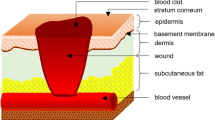Abstract
The use of ordnance gelatine has been widespread in the field of ballistics as a simulant for soft tissue when assessing ballistic threats. However, the traditional method of preparing ordnance gelatine is time-consuming and requires precision to ensure that the final mold meets the required specifications. Furthermore, temperature control is necessary post-production, and there are limitations on its usage duration. To address these issues, manufacturers have developed pre-mixed, gelatine-like products that are stable at room temperature and require less preparation time. Nonetheless, it is uncertain whether these new products can perform in the same manner as the gold standard of ordnance gelatine. This study used five types of blocks, including ordnance gelatine (10% and 20%), Clear Ballistics (10% and 20%) and Perma-Gel (10%) and subjected them to 9 mm, 0.380 Auto fired from a universal receiver and a 5.56 × 45 mm ammunition fired by a certified firearms instructor. Delta-V and total energy dissipation were measured after each test using data collected from ballistic chronographs placed in front of and behind each block. High-speed video was recorded, and a cut-down analysis conducted. The findings revealed variations in energy dissipation and fissure formation within the block, with greater energy based on fissure formation observed in the ordnance gelatine. Additionally, the high-speed video showed the occurrence of secondary combustions occurring in the premixed gelatines.







Similar content being viewed by others
Data availability
Not Applicable.
References
Janzon B (1997) Projectile-Material interactions: simulants. Scientific foundations of Trauma. Oxford University Press, pp 26–52. G.J. Cooper, H.A.F. Dudley, and D.S. Gann, Editors
Sellier KG, Kneubuel BP (1994) Wound ballistics and the scientific background, 1st edn. Elsevier, Amsterdam
Jussila J (2005) Measurement of kinetic energy dissipation with gelatine fissure formation with special reference to gelatine validation. Forensic Sci Int 150(1):53–62
Bir CA, Stewart SJ, Wilhelm M (2005) Skin penetration assessment of less lethal kinetic energy munitions. J Forensic Sci 50(6):1426–1429
Fackler ML, Malinowski JA (1985) The Wound Profile: a visual method for quantifying gunshot Wound Components. J Trauma-Injury Infect Crit Care 25(6):522–529
Bir CA, Resslar M, Stewart S (2012) Skin penetration surrogate for the evaluation of less lethal kinetic energy munitions. Forensic Sci Int 220(1–3):126–129
Cail K, Klatt E (2013) The effect of intermediate clothing targets on shotgun ballistics. Am J Forensic Med Pathol 34(4):348–351
Fackler ML, Bellamy RF, Malinowski JA (1988) The wound profile: illustration of the missile-tissue interaction. J Trauma 28(1 Suppl):S21–S29
Knudsen PJ et al (1995) Terminal ballistics of 7.62 mm NATO bullets: experiments in ordnance gelatin. Int J Legal Med 108(2):62–67
Corzine A, Roberts G (1993) Correlation of Ordnance Gelatin Penetration Results between 20% gelatine at 10°C and 10% gelatin at 4°C. AFTE J 25(1):2–5
Maiden NR et al (2015) Ballistics ordnance gelatine - how different concentrations, temperatures and curing times affect calibration results. J Forensic Leg Med 34:145–150
Haag L, Jason A (2020) Synthetic gelatins as soft tissue simulants. AFTE J 52(2):67–84
Cronin D, Falzon C (2010) Characterization of 10% ballistic gelatin to EvaluateTemperature, aging and strain rate effects. Experimental Mechanics, p 25
Mabbot A et al (2013) Comparison of 10% gelatine, 20% gelatine and Perma-Gel TM for ballistic testing. in International Symposium on Ballistics. Freiburg, Germany
Bir C, Villalta R, Bodo M (2018) Comparison of Various Gelatine Surrogates for Wound Track Assessment. in Personal Armour Systems Symposium 2018. United States
Schyma CW (2010) Colour contrast in ballistic gelatine. Forensic Sci Int 197(1–3):114–118
Schyma C, Madea B (2012) Evaluation of the temporary cavity in ordnance gelatine. Forensic Sci Int 214(1–3):82–87
Carr DJ, Stevenson T, Mahoney PF (2018) The use of gelatine in wound ballistics research. Int J Legal Med 132(6):1659–1664
Schyma CWA (2020) Ballistic gelatine-what we see and what we get. Int J Legal Med 134(1):309–315
Mabbott A et al (2016) Comparison of porcine thorax to gelatine blocks for wound ballistics studies. Int J Legal Med 130(5):1353–1362
Acknowledgements
The authors would like to acknowledge the following individuals for assisting with the testing of the gelatine blocks: Gabe Glasser, John Moors, Aliyah Arunasalam, Jenna Wahbeh and Aaron Chan.
Funding
The authors did not receive support from any organization for the submitted work. The authors have no relevant financial or non-financial interests to disclose.
Author information
Authors and Affiliations
Corresponding author
Ethics declarations
Research involving human participants and/or animals
Not Applicable.
Informed consent
Not Applicable.
Ethics approval
Not Applicable.
Additional information
Publisher’s Note
Springer Nature remains neutral with regard to jurisdictional claims in published maps and institutional affiliations.
Rights and permissions
Springer Nature or its licensor (e.g. a society or other partner) holds exclusive rights to this article under a publishing agreement with the author(s) or other rightsholder(s); author self-archiving of the accepted manuscript version of this article is solely governed by the terms of such publishing agreement and applicable law.
About this article
Cite this article
Bir, C., Menkara, A., Villalta, R. et al. A comparison of gelatine surrogates for wound track assessment. Int J Legal Med (2024). https://doi.org/10.1007/s00414-024-03221-3
Received:
Accepted:
Published:
DOI: https://doi.org/10.1007/s00414-024-03221-3




